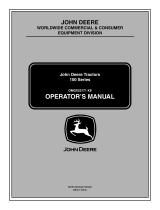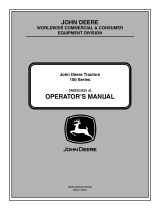
3 — English
IMPORTANT SAFETY INSTRUCTIONS
Replace blade if it is bent or cracked. An unbalanced
blade causes vibration that could damage the motor
drive unit or cause personal injury. Sharpen a dull blade
equally at each end to maintain the balance. Clean the
blade thoroughly and check its balance by supporting
it horizontally on a thin nail through its center hole. The
nail should be in a horizontal position. If either end of the
blade rotates downward, remove some metal from the
heavy lower end until the blade is balanced. It is balanced
when neither end drops.
The side discharge chute is a spring-loaded guard that
covers the side discharge opening on the mower deck
and deflects grass clippings and debris away from the
operator. Always ensure that the motor is off and the
blades have stopped moving before inspecting, mov-
ing, cleaning, or performing maintenance on the side
discharge chute.
Always use safety protective devices. Do not operate
the mower without the side discharge chute in place
and working properly. Mulch cover should be correctly
installed and working properly during mulching operation
and bagger kit should be correctly installed and working
properly during bagging operation.
Never interfere with the intended function of a safety de-
vice or reduce the protection provided by a safety device.
Check their proper operation regularly.
Never tamper with safety devices. Check for proper op-
eration regularly.
Follow manufacturer’s instructions for proper operation
and installation of accessories. Only use accessories ap-
proved by the manufacturer. The use of other accessories
may increase the risk of injury.
Clear the work area before each use. Remove all objects
such as rocks, sticks, metal, wire, bones, toys, fallen tree
limbs, tree nuts, or other objects which can be thrown by
the blade.
Objects struck by the lawn mower blades can cause
severe injuries to persons. The lawn should always be
carefully examined and cleared of all objects prior to each
mowing.
If the lawn mower strikes a foreign object, follow these
steps:
• Stop the lawn mower, set the parking brake, wait until
the blades come to a complete stop, and then remove
start key.
• Thoroughly inspect the mower for any damage.
• Replace the blade if it is damaged in any way. Repair
any damage before restarting and continuing to operate
the mower.
Slopes are a major factor related to loss of
control and tip-over accidents, which can
result in severe injury or death. Operation on
all slopes requires extra caution. If you can-
not back up the slope or if you feel uneasy
on it, do not mow it. Never use on steep slopes greater
than 15°.
• Never attempt to ride on a steep slope or mow a slope
that is greater than 15°. To determine the angle of your
slope, use the Slope Guide at the back of this manual.
• Mow up and down slopes, not across.
• Watch for holes, ruts, bumps, rocks, or other hidden
objects. Uneven terrain could overturn the machine.
Tall grass can hide obstacles.
• Use a slow speed so you will not have to stop suddenly
or accidentally accelerate while on a slope.
• Do not mow on wet grass. Tires may lose traction and
you may lose control.
• Always keep the direction control switch in the forward
position when going down slopes. Do not shift to neu-
tral and coast downhill, which may cause you to lose
control of the mower.
• Avoid starting, stopping, or turning on a slope. If the
tires lose traction, disengage the blades and proceed
slowly straight down the slope.
• Keep all movement on slopes slow and gradual. Do
not make sudden changes in speed or direction, which
could cause the machine to roll over.
• Use extra care while operating machine with baggers
or other attachments; they can affect the stability of the
machine. Do not use on steep slopes greater than 15°.
• Do not try to stabilize the machine by putting your foot
on the ground.
• Do not mow near drop offs, ditches, or embankments.
The machine could suddenly roll over if a wheel goes
over the edge or if the edge caves in and result in death
or serious personal injury.
Never direct discharged material toward anyone. Plan
your mowing pattern to avoid discharge of material to-
ward bystanders, roads, sidewalks, windows, cars, and
the like. Also, avoid discharging material against a wall
or obstruction, which may cause the material to ricochet
back toward the operator.
Stop the blade when crossing gravel surfaces to avoid
discharging gravel and rocks and drive the mower slowly
and carefully to avoid loss of control.
Use extra care when approaching blind corners, shrubs,
trees, or other objects that may block your view.
Never make any adjustments or repairs with the motor
running and/or blades moving. Turn off power switch and
remove key.
Stop the motor, set the parking brake, wait until the
blades come to a complete stop, and remove start key
before unclogging the side discharge chute or opening.
The cutting blades continue to rotate for a few seconds
after the motor is shut off. Never place any part of the






















